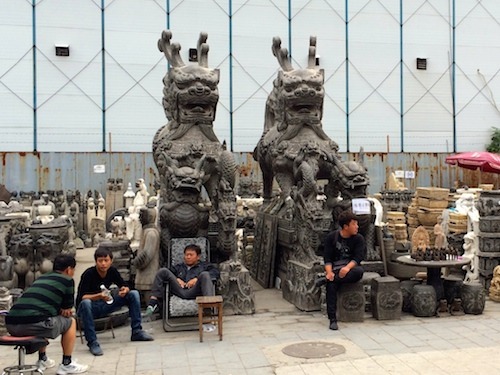Panjiayuan Antiques Market (潘家园旧货市场)

After having lived in Beijing for over a year and having never been to the Panjiayuan Market, I was surprised to find that this market found its way onto just about every “Top 10” list of Beijing I could find. After going, I can see why. True, I doubt the authenticity of many of the items, but no where else in Beijing can you see such a concentrated selection of Chinese culture in one place. Even as someone who has travelled to many places in China, I was impressed by this market. I think this market is a great introduction to Chinese handicrafts, especially if you just have a short time in Beijing. I agree with the other sources: Panjiayuan Market is a must see!
This famous market covers 48,500 square meters with more than 3,000 individual stalls popped up in 1992 as a small roadside market. Now they proudly hold the title of Best Antique Market in China. They love to brag that even Hillary Clinton has shopped here. Although the antique zone of market is open everyday, the arts and crafts warehouse zone is only open on the weekends, so it is your best bet to go on the weekend and experience the Panjiayuan Market at its finest and busiest. There’s nothing quite like the feeling of walking through an unassuming entryway to find yourself in the midst of a vast bustling market. It’s very overwhelming at first, but once you start wandering and get your bearing, you’ll really love it!
When to go? Weekends are recommended.
Mon-Fri 8:30-18:00
Sat-Sun 4:30-18:00
How to get there? Easy, take the metro to Panjiayuan (潘家园), exit B. The exit drops you off at a crowded intersection with lots of street peddlers. Upon exiting, go up the stairs on your left, up on the bridge, and turn left (to the West for those of you who carry compasses).

Orientation:
A) Stone carving area (石雕石刻区): in the southwest corner of the market, beyond the parking lot, this area contains massive and impressive Chinese and Buddhist stone carved statues

B) Antique furniture warehouse (古典家居大棚): next to the stone carving area and the parking lot, these buildings contain many elegant classical style Chinese furniture stores

C) “High-rank” antique store area: is not so much an area, but the rest of the housed shops encircling the large open market area
D) Antiquated books and scrolls area (古旧书刊区): this little alleyway lies along the southern-most edge of the market containing exactly what you think

E) Miscellaneous Antiques (古玩杂项): the open market area in the middle consists of four zones
- Jade artifacts (翡翠玉器), pearl agate (珍珠玛瑙), bamboo/wood/bone carvings (竹木骨雕), inside paintings of snuff bottles (内画工艺), and calligraphy and paintings (字画)
- Miscellaneous antiques (古玩杂项), secondhand goods (民间旧货), ancient coins (古旧钱币), and modern collection (现代收藏)
- Folk crafts (民间工艺), ethnic minority clothing and accessories (民族服饰), “scholar’s 4 jewels” or the essentials of calligraphy (文房四宝), buddhist paraphernalia (佛教物品), wood carved panels (木雕滑板), and more calligraphy and paintings (字画)
- Porcelain and bronze vessels (瓷器铜器), purple sand technology (紫砂工艺)(I had trouble translating this one >

